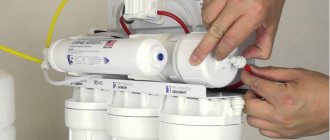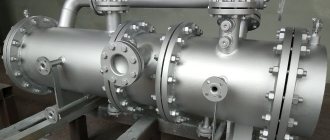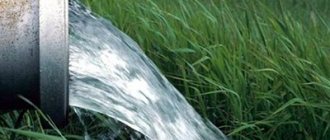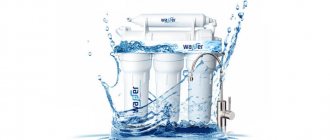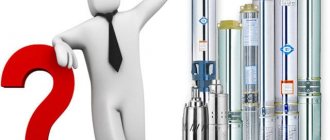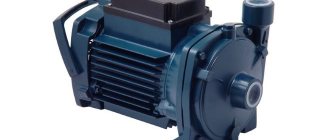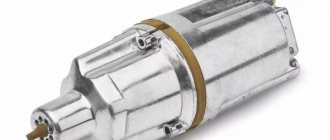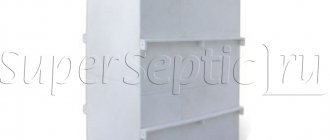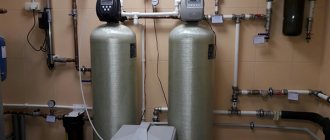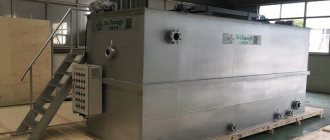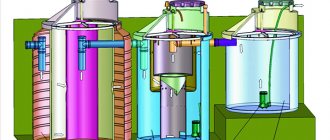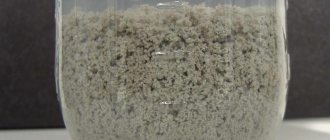In private households, they often choose their own source of liquid supply. This may be more economical than connecting to a centralized water supply, or the only possible option in a given area. Many believe that the liquid from its source is softer and more suitable for drinking, since it does not undergo chlorination and treatment with other chemicals, but only if mechanical filters are correctly installed to purify water for a well at home.
When is filtering necessary?
The answer will be the same - always. But the degree of purification can be different; in some cases, only mechanical removal of contaminants is necessary, and in others, getting rid of chemical impurities, when the composition does not meet the requirements of SanPiN and other standards.
In both cases, first of all, they suggest installing a deep cleaning filter, which simultaneously has two current tasks:
- prevents the ingress of coarse particles: sand, clay, pebbles, etc.;
- protects equipment from premature damage and wear.
We draw your attention to the fact that small inclusions of soil that can get into your home water supply will not only spoil the taste of food and can harm your health, but also negatively affect the shut-off valves and the pipes themselves. All pipeline elements become clogged and soon deteriorate and break.
This filtration element is called the first stage. But to use well water, you must not only clean it of impurities, but also determine its chemical composition.
Despite the fact that a well is considered a more preferable and safer option than a well, since the latter source is open and the former is closed, it may also contain impurities that are undesirable for drinking.
The amount and type of suspended particles mainly depends on the soil, site, and the immersion depth of the pumping equipment. Typically, the depth of immersion depends on the depth and type of water supply. There are these options:
- Abyssinian well - high purity, low mineralization, but the presence of nitrites, nitrates, ammonia, pesticides is possible, especially if the soil has been pre-treated with chemicals or there are agricultural land plots nearby.
- A well for sand is a more often used option, because the quality of the liquid is practically not affected by the condition of the earth above. In addition, mineralization is even lower than that of the Abyssinian. However, there may be impurities from substances such as iron and calcium, as well as some pathogenic microorganisms.
- An artesian source is the deepest, best option. It is often used as drinking water, because the microbiological composition almost always excludes harmful substances. But there is also a minus - there can be a lot of mineral parts due to possible deposits of mineral deposits in the layers of the earth. These are, first of all, hardness salts, inorganic iron and manganese. This leads to a brown or even black coating remaining on the dishes after settling or boiling.
Thus, we conclude that, regardless of the type of water source, it is necessary to submit samples for analysis to determine the type of filtration of water from a well in a private house.
During such a test the following indicators are determined:
- presence of color or transparency;
- cloudiness;
- the amount of iron and other metal and non-metal impurities;
- oxidation level;
- degree of alkalinity;
- pH balance;
- presence of microorganisms and their concentration.
All this data will help you understand how bad or good the quality of the liquid is, and whether it can be used, including for drinking purposes. And what kind of filtration is needed.
Another reason is a decrease in hardness or, in other words, softening. It is necessary for everyone who plans to use any heating devices. And this is not only a kettle, but also heating elements in boilers, as well as in various household appliances (washing machines, dishwashers). Heating elements with increased hardness quickly become covered with scale.
To get rid of the above reasons, you need to install an additional water filtration system from the well. Such filters solve the following problems:
- Removes harmful toxins.
- They cope with organic matter - the main cause of infections and diseases.
- Soften the liquid.
- They make it tastier - without a salty or sharp, sour taste or smell.
- They will make it safe for drinking.
- Remove +2 and +3 iron from water.
The main problems with well water are iron, hardness and heavy metals.
The biggest and most fundamental problem of well water is general pollution, which includes a lot of problems with water. It is absolutely not cleaned. And there’s just so much more to it. And purifying such water is a job for a pro! It is unlikely that it will be possible to clean such water on your own, unless the owner of the house is the head of a company that produces treatment systems.
What impurities are most often found in such water? The set is most impressive.
| Place of extraction | Impurities |
| Well, well | Solid impurities (sand, pebbles) Rigidity Dissolved iron salts Heavy metals Bacteria Hydrogen sulfide |
About underground springs, we can say that there is almost no ordinary garbage there, and bacterial contamination is small, but there is plenty of dissolved metal salts, hardness, and especially iron, because Water, an excellent solvent, dissolves everything it can along the way.
What is the best water filter for a well? The selection should always be based on the identified problems with the water itself. But what and how to do to correctly identify all negative impurities? The very first thing you cannot save on is chemical analysis of water. Water should be taken for analysis correctly. But it must be said that hardly anyone would decide to build a water and heating purification system without the involvement of specialists. Therefore, assessing the state of water will be part of the work package.
Such a check makes it possible to identify not only the full composition of impurities, but also their size. With such a set in hand, the question of which water purification filter to choose for a well can be resolved much faster. Moreover, the analysis will show the complex composition of impurities. And it will already be possible to roughly draw up a water treatment system and estimate future costs.
The best types of systems
After chemical analysis, a choice must be made. Another criterion is where the source itself is located and how deep the drilling was. Let's look at the filter options.
Gravel
MBFT-75 Membrane for 75GPD
SF-mix Clack up to 0.8 m3/h
SF-mix Runxin up to 0.8 m3/h
It is called the simplest and at the same time inexpensive. Its main task is to prevent the penetration of large soil particles into the water supply system, that is, fairly rough cleaning is carried out. What conditions are needed to install the system:
- It is necessary to prepare pipes of a smaller diameter than the outlet of the well pump;
- Gravel pebbles should be small to retain smaller particles;
- The gravel layer should be large enough - from 90 cm to 2 meters.
It should be noted that if the well is located in an area where the soil is predominantly sand, rapid clogging will occur, so it is better to install a second protection, for example, a mesh.
Let's highlight the advantages:
- Simple and practical design.
- Protection of downhole instruments from rust.
- The ground is fixed and protected from landslides.
- The system is completely natural, so you don’t have to worry about the safety of its use and the taste of the purified liquid.
Mesh filter for water well: features, how to choose
It is considered one of the most effective and applicable on sandy rocks, because with its help the smallest particles of contaminants are retained. Inside there is a grid of tiny cells, which can have a shape - square, keeper, galloon, or multilayer. To choose the right nozzle, you first need to do an analysis - it determines what size the minimum fractions of impurities are. Based on this, the best option is selected from 0.12 to 3 square millimeters.
When purchasing, it is worth noting that high-quality products are made only from stainless steel to prevent corrosion. They have a service life of up to 50 years. In this case, dimensional units are determined in the number of vertical and horizontal wires per cell, for example, 6/40.
Advantages:
- good quality – the smallest particles are retained;
- ease of installation and repair;
- if several torn areas appear, the filtration result will remain virtually unchanged.
There are also disadvantages, for example:
- manufacturing materials are quite expensive;
- When used, the liquid pressure decreases.
Slotted
This is another option for what filters are installed on wells, especially if they are located on soil that is prone to collapse. These types include sand, pebbles and crushed stone.
Pros:
- retains rock particles of quite different sizes;
- ideal when you need to handle a small pressure;
- the perforated pipe that underlies the system can experience high pressure, since it is made of durable material;
- low price.
The downside is that since the slots are quite narrow, they quickly become clogged and need to be cleaned. In addition, the harder the water, the more there should be.
Perforated (holey)
This is one of the subtypes of the previous filter, with the same design, but the shape of the holes is different - a small number of them on the pipe itself + mesh. This makes it more stable, even in deep wells. But the throughput is quite low - the flow becomes smaller, this is due to the fact that it is necessary to overcome double protection.
AMETHYST - 02 M Residential building for up to 10 people or up to 2 cubic meters/day.
Aeration unit AS-1054 VO-90
Main table dispenser AquaPro 919H/RO (hot and cold water)
Wire
Essentially, this is a good combination of three types, that is, the product consists of:
- a sump through which liquid passes;
- perforated pipe, as in a slotted one;
- wire mesh like mesh.
They have a very long service life due to the fact that wire is used - it is more reliable than a mesh network, does not rust and can last up to 30 years without problems. However, there is a big drawback - the size of the structure. Due to its dimensions and, in general, complex configuration, it is almost impossible to remove it for cleaning, repair or dismantling and subsequent reinstallation in another location.
What is a well filter
Borehole water filters are installations that can be stand-alone or built into pumping equipment.
As a result, they are divided:
- For factory-made products.
- Homemade filter units.
Material for making:
- Plastic.
- Stainless steel.
Need to know:
- The best characteristics are those made from stainless steel. They are durable and source safe. They consist of a pipe base, a filter mesh, and a frame, which consists of wires of different diameters.
Note. The filter mesh is also made of stainless steel.
- When choosing such equipment, the dimensions of the structure in which it is installed are of great importance. Its diameter should be slightly smaller than the diameter of the well.
- Filtration equipment must be selected based on soil analysis. Only then can it last a long time.
Note. Quite often, sellers try to pass off a galvanized steel filter as stainless steel. When purchasing, you must immediately check with the seller about the documents for the product, which indicate the material for its manufacture.
- For this reason, you should opt for filter frames made only from stainless steel, since zinc can have a harmful effect on human health.
- It is also worth considering that polymer (plastic) ones are not as hygienic as stainless steel ones and are less durable in use.
Note. The price of stainless steel products is higher than that of polymer ones.
Cleaning options
There are three stages of water treatment, they consist of:
- mechanical cleaning;
- chemical filtration (absorption);
- disinfection.
Let's talk in more detail about them.
Primary water filtration
It is necessary for any source, and it does not matter how it will be used. It is designed to trap areas of silt, sand, rocks and any debris that may end up in the garbage disposal. The options listed above (gravel, crevice, wire) refer specifically to rough cleaning.
Deep water treatment systems
Installation of such equipment is necessary in country houses or cottages that are installed in areas with a high content of salts or other impurities in the soil. This is easy to determine - you need to submit the fluid from the well for examination and determine its composition. Also included in this category are types that are intended for disinfection, that is, to eliminate any bacteria that are in the liquid.
We list the methods of deep water purification:
- Ion exchange filtration. The ion exchange method is based on the ability of certain substances to change their ionic composition. Magnesium and calcium ions are retained, and in return the water is enriched with sodium ions. The resulting salts are not deposited as scale and do not have a negative effect on humans.
- Membrane. H2O molecules are very small in relation to any impurities, so they pass further through the smallest membranes, while other elements remain on this barrier. In terms of efficiency, this is one of the best methods, but it should be remembered that any salts also do not pass into the water supply, so desalting occurs, which is not very good for a drinking source.
- With regular or modified loading. Multifunctional devices are loaded with a unique composition of sorbents, which provide a high degree of purification from manganese, iron and organic matter, and also soften them by removing hardness salts.
- Coal devices for water from a well. Suitable for the very final stage, because it removes organic matter most effectively.
- Disinfectants. Used to fight bacteria. They are based on ultraviolet installations.
Learn more about the two most common types of secondary water treatment.
Device
The filtration scheme provides for periodic cleaning and prevention of contamination. To remove foreign impurities, store-bought or homemade filters with fillers are used. High-quality purification of water from iron from a well allows you to obtain artesian fluid. Otherwise, glandular compounds will negatively affect the state of the immune system, suppressing its protective functions.
To reduce the concentration of this element to an acceptable level, it is important to take into account the following nuances:
- The liquid is supplied to a gravel or salt filter for water from a well using a hose and enters a special environment with several degrees of water purification.
- Soluble impurities are converted to insoluble form.
- Water is passed through a well gravel filter and directed into the stem. Third-party components are completely removed from the system.
- Iron impurities accumulate in a separate compartment and are then washed out.
To prepare artesian water, you do not need to add any reagents to the system. Regeneration is carried out automatically using a control valve.
Aeration filtration is performed using an oxidizing agent (in most cases, activated carbon). During cleaning, a compressor unit is used, which enriches the liquid with oxygen. Using coal, you can accelerate the chemical reaction of oxidation of ferrous compounds and remove sediment.
Ionic resin is considered an alternative treatment for highly contaminated water. The natural filtration method is based on the use of natural minerals such as manganese dioxide. The reagent oxidizes substances and then removes them from the system during flushing.
The set of water treatment measures consists of the following stages:
- Aeration.
- Ozonation.
- Chlorination.
- Removal of foreign impurities.
Sorptive
This is a design of several cartridges that contain carbon, resins with a high content of ions, and silver. They periodically require replacement and can be changed individually depending on what exactly has gone bad. The frequency depends on how hard and dirty the liquid is.
Main table dispenser AquaPro 929CH/RO (cooling/heating)
Floor dispenser AquaPro 311 (empty, without cooling)
Floor-standing dispenser AquaPro 6207CH (cooling/heating/room temp.)
If the analysis shows that the liquid does not contain all the elements, but only some impurities that require their removal, then you can install not all cartridges at once, but, for example, only carbon.
Reverse osmosis
The reverse osmosis system is the same membranes that we described earlier. Its presence allows for filtration at the molecular level. In order for this separation to occur and pressure to be maintained, pumping equipment is necessary. At the outlet, the liquid is close to distilled.
You can also find such aftertreatment options as:
- chlorination – used in main pipelines, kills bacteria well;
- ozonation - ozone reacts with certain molecules, their compound is considered insoluble and is easily removed;
- ultraviolet radiation – disinfection without changing the chemical composition;
- aeration - the oxygen with which the system is saturated oxidizes metal inclusions and they precipitate.
The principle of water purification from a well
Water is purified using chemical and physical principles. Chemical reactions include reactions of substances to each other. So iron in the presence of oxygen oxidizes and precipitates. Also, the oxidation reaction is provoked using catalysts and reagents. This group also includes chemical compounds capable of ion exchange.
There is mainly one physical principle used in water treatment - filtration. Passing through mechanical filters, water leaves large inclusions in them and is cleaned of turbidity and dirt. Such filter materials are mainly used in the first and last stages of purification.
What height to choose
To ensure that the pressure is sufficient for use and there is no need for an additional pumping station, the following recommendations should be followed:
- The less the well pipe flows, the higher the cleaning equipment needs to be installed.
- At least 1 meter.
- For sandy soil - from 2 m or more with a pipe diameter of 10-15 cm.
- Fine sand must be deepened to 4 m, and the dust structure to 6 m.
How to install a coarse filter
Pipe perforation
Any home-made treatment structure (slotted, perforated cut) is prepared on the surface with your own hands before casing begins. To do this, holes are formed on a polypropylene pipe using a hammer drill or a gas cutter. Their arrangement is in lines or in a checkerboard pattern. The indentation step is 1.5-2 cm. All holes must be made at a distance of 100 cm from the bottom edge of the column. The bottom of the pipe must be closed with a wooden stopper or welded.
The finished perforation is wrapped in mesh. The cell size is selected experimentally. They are trying to pour water mixed with sand of different fractions through the mesh. It is good if the cells do not allow more than 50% of the granules to pass through.
The mesh is secured with rivets or spot welding.
When ready, the pipe with the bottom filter is lowered to the bottom of the source, building up the column in solid sections.
When installing a gravel filter, there is one condition - the diameter of the source must be larger than the cross-section of the casing. In other cases, you may not even begin to install gravel layers. After the lower perforated part of the shaft is lowered into the well, it is sprinkled with coarse and medium-fraction gravel. The thickness of the layer is along the entire height of the perforation.
Features for a country house or cottage
Decide in advance the main question - what purposes the water source will serve. It is installed for drinking or only for washing and other household needs. And also decide whether the use will be year-round or seasonal. If you will live in the cottage permanently and plan to drink and cook food directly with liquid from the tap, then you should install both a carbon and reverse osmosis device.
We recommend contacting. Specialists select equipment based on the above analysis and usage characteristics. The company offers not only to install devices on ready-made sources, but also to independently engage in design, drilling, and supplying water supply to the house.
